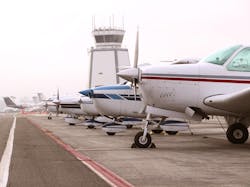Airport Sponsors Play a Critical Role in Providing Coronavirus Relief
The Coronavirus Aid, Relief and Economic Security Act (CARES Act) provides some assistance for small businesses through loans and payroll relief, and also offers aid to airlines and airports with commercial airline service. However, it falls short in addressing the financial crisis faced by thousands of aviation businesses that provide vital services to our nation’s air transportation system. Of the approximately $10 billion in grants for airports contained in the CARES Act, only $100 million is allocated to the approximately 4,500 general aviation public use airports.
Aviation businesses in the U.S. support 1.2 million jobs and $247 billion in annual economic activity. General aviation companies operate at nearly 3,500 U.S. airports and thousands of areas not served by the airlines. The aviation activity in these cities and towns cultivate well-paying jobs, economic activity and connectedness. In times of crisis, they support the movement of flights carrying medical and testing equipment, cargo, agriculture, emergency services personnel and humanitarian relief supplies.
Ultimately, commercial aeronautical businesses that are unable to meet the obligations of their lease agreements imperil the ability of airport sponsors to operate safely and efficiently. Some airport tenants may be eligible for the small business support provided in the CARES Act via a grant or loan guarantee program. However, the many restrictions associated with implementation make participation burdensome, undesirable and often unobtainable.
For example, Title IV, subpart B of the CARES Act – providing relief to air carriers, air cargo and contractors to the airlines – allows the Secretary of Treasury to demand warrants, an equity interest or other financial instruments in their companies to participate in the Air Carrier Worker Support Program where the funds can only be used for payroll. Participating businesses are also prohibited from share buybacks, paying dividends or making capital contributions from the date of the grant through September 30, 2021.
Among these and many other restrictions, commercial aeronautical businesses must also commit to not having any involuntary furloughs from the date of the grant through September 30, 2020. In addition, well after the Air Carrier Worker Support Program was put into law and the priority deadline passed for eligible company applicants, the Secretary of Treasury waived the financial instrument requirement for smaller participating companies.
Notably, the National Air Transportation Association (NATA) spearheaded efforts and achieved success in getting Part 135 certificated charter operators and Part 145 MRO businesses included in the package provided to the airlines. Additionally, FBOs that provide ground handling services to commercial airlines are eligible for some relief. However, the bulk of relief provided by the CARES Act aimed at aviation was written with commercial airlines in mind and ignored smaller general aviation airports and businesses.
For example, approximately 188 airports in California are sharing approximately $1 billion in federal aid.
Los Angeles International Airport was allocated $323.6 million, the most funding of any airport in the state. However Van Nuys Airport, one of the nation’s busiest general aviation reliever airports, was apportioned only $157,000. Adding to an already dire situation, Congress included a flawed formula in the CARES Act that erroneously gave a disproportionate advantage to some smaller airports, while leaving some busier airports relatively unassisted.
What is the role of the airport sponsor in providing aid to ailing airport tenants? According to the Federal Aviation Administration (FAA) – whose primary concern is that federally obligated airports remain safe and open – the decision to abate rent (including minimum annual guarantees and encompassing fees) is a local responsibility. Thus, airport sponsors have the authority to either waive or defer commercial aeronautical rents without violating federal grant assurances.
This supports the strong case made by aviation industry associations such as NATA that airport sponsors must take critical and swift action to address leasehold issues faced by general aviation businesses in the wake of COVID-19, including some form of rent relief for tenants. It is also vitally important for airport sponsors who own or operate multiple airports to understand their authority to use funds allocated by the CARES Act at any airport under their control.
Overall, the majority of airport sponsors are public agencies tasked with sustaining airport operations and revenue streams to preserve jobs and services that benefit the community. Both airport sponsors and commercial aeronautical businesses must work collaboratively and creatively to rise above the old normal and create uniform rapid relief programs. They must also be careful to avoid changes in non-aeronautical rents and fees that would shift the burden of recovering lost revenue to commercial aeronautical users.
To that end, NATA has created a white paper that airport sponsors and their tenants can use as a guide for conversations on financial accommodations that are aligned with current federal regulations. Titled “Recommended Practices for Airport Sponsors and Commercial Aviation Businesses in Addressing Leasehold Issues in Response to COVID-19,” this document suggests that uniform and equitable financial assistance for similarly situated tenants is critical, in particular for aeronautical service providers and master leaseholders whose subtenants may be petitioning them for relief.
In addition, the FAA document titled “Information for Airport Sponsors Considering COVID-19 Restrictions or Accommodations” specifically states that sponsors considering such relief are encouraged to consider 1) the business situation of the tenant, 2) the changed circumstances created by the public health emergency, 3) the desirability of having solvent tenants that can resume normal operations when the emergency ends, 4) the availability of other governmental or insurance relief that such entities have or may receive, 5) an appropriate term for such relief and 6) possible subsequent conditions that, if triggered, would end the abatement. Such a condition could be the receipt of other governmental forms of relief, insurance recovery or an end to the emergency.
Finally, airport sponsors might find more creative, out-of-the-box solutions by taking a deeper look at the commercial real estate industry. For example, an airport sponsor may offer a commercial aeronautical business a longer-term lease to ensure its revenue stream and offset negative economic impacts over an additional few years. This option avoids the zero cash flow caused by a tenant going out of business, protects the current land valuation and eliminates reduced land rents caused by a drastic depreciation of the business economy.
Today, NATA continues to work on legislation that would provide support to airports and aviation workers, as well as preserve our nation’s critical infrastructure during a time of crisis. It is seeking
$9 billion to support the payroll of general aviation sponsors and certain aviation tenant businesses. Recipients would be prohibited from receiving assistance under the CARES Act and would be required to maintain employment and payroll levels through the end of the calendar year.
The general aviation airports that support our national aviation system are self-sustaining entities that rely on user fees and rental income from their tenants to remain healthy. Airport sponsors must make every effort to provide commercial aeronautical businesses the payroll and lease obligation relief necessary to move forward with our nation’s economic recovery efforts and protect critical infrastructure.
Curt Castagna, president and CEO of Aeroplex/Aerolease Group, is a member of the Los Angeles County Airport Commission, president of the Van Nuys and Long Beach Airport Associations, and board chair of the National Air Transportation Association. A certified private and instrument-rated pilot, he has instructed courses in aviation administration at Cal State Los Angeles for over two decades.
About the Author

Curt Castagna
President and CEO
Curt Castagna, President/CEO of Ascension Group Partners, serves as president and CEO of the National Air Transportation Association, member and past chair of the Los Angeles County Airport Commission, and president of the Van Nuys and Long Beach airport associations. A certified private, seaplane and instrument-rated pilot, he continues to instruct courses in aviation administration at Cypress Community College and Cal State Los Angeles.
